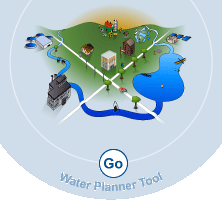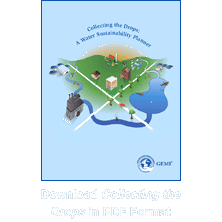
|
|
Module 1Facility Water Use and Impact Assessment ProgramDiscussion of Water Program Content and Key Considerations The facility user may want to consider and evaluate the operations’ overall use of water and the impact on the regional water supply. This module is provided to assist with the preparation of a water block flow diagram and perform a simple water balance that will provide an approximation of overall use and disposition. Note: Much of the information generated through this process will be requested as input to the water management risk questionnaire in Module 2. Module Purpose and Approach The purpose of Module 1 is to guide the user through the tasks required to assess the facility’s relationship to water by:
These steps will provide a more comprehensive understanding of the relationship to water. Water Block Flow Diagram and Water Balance Program The facility user should be prepared to invest time to understand water supply including the quality and quantity used, losses of water to air, losses to land, water retained in the product and the final disposition of the water once used (water discharged). A simple flow diagram can be prepared by linking the water supply to each location where water is used. The process unit can be the entire facility, a building containing several production processes, a particular production process, the utilities area or specific unit operations (e.g., the cooling towers). The process unit could also be defined as a type of usage such as sanitary usage (i.e., the water consumed by facility employees, used in toilets, showers and in food preparation). After defining a process unit, the user can draw an imaginary dotted line around the process unit and identify and ultimately quantify the water inputs, water losses (to air, land and to product) and wastewater discharge. Lines should connect to each block (labeled with the name of the water-using process) and should include information of total water flow per unit time and water quality. A water balance case example, flow calculations and "rules of thumb" are provided as links in Module 1 for use during the preparation of the water flow diagram. Once completed, the combination of process steps (boxes) and flows (lines), from supply through final process prior to discharge, represents the facility’s comprehensive water flow diagram. Figure 1 represents a Sample Water Flow Diagram. Figure 1. Sample Water Flow Diagram The next step is developing a simple water balance by assessing the total water used (inputs) minus the volume of overall losses in production and wastewater discharged (outputs). A simple Water Balance Program is provided for this purpose. General Water Balance Calculation A water balance is an inventory of the water in a system. The purpose of developing a water balance is to prioritize the major water uses in the facility where potential water conservation and reuse opportunities could exist based on process water quality requirements. After the user has prepared a water flow diagram, the next step is to perform a facility wide water balance. The facility water balance is often a simple exercise because raw water and wastewater flows are commonly metered. Subtract the total water supplied to the facility from the total wastewater discharged from the facility. The remainder is the amount of water that is lost to air through evaporation, to the land through irrigation, leaks or retained in the product. The next step for the user is to perform a water balance for each water use to account for facility losses. Prepare separate diagrams for utilities, production, sanitary, irrigation and all other uses. A link to a hypothetical water balance case example is provided for reference in Module 1. Water systems can be very complex and can have a number of water inputs, losses and outputs to wastewater or recycle/reuse. Facilities generally do not have separate water meters covering these operations. The facility engineer is called on to estimate water uses in the various areas. This is commonly done by a combination of methods including engineering calculations/factors, process knowledge and the installation of water meters and/or wastewater measuring devices. Some common estimating tools are provided later in this module. A Block Flow Diagram is very important when developing the water balance. A simple spreadsheet can be used for more complex systems using multiple inputs, losses and outputs. Figure 2 provides a basic schematic that can be used for calculating a water balance:Figure 2. Sample Block Flow Diagram Typical Process/Facility Water Balance Calculation
VARIABLE DEFINITIONS: A - (B + C) = Balance or Discrepancy Water Balance Program The Water Balance Program includes three spreadsheets that require inputs for water supplied, process/facility losses and total volumes discharged or returned. The program calculates a result based on user input that will indicate a complete balance or a discrepancy (water unaccounted for). The program also provides a percent closure result. Acceptable margins of error based on discrepancy percentage versus average volume of water used are provided. The water balance is an important step to obtain sufficient information about water usage and assess if opportunities exist to reduce, reuse or recycle water. Table 1 represents a Water Inventory Calculation.
A water-related engineering calculation and reference information link is provided in Module 1. Water-related calculations and “rules of thumb” are included in this module to assist with the water balance activity. Table 2 provides examples of the water-related calculations and “rules of thumb” that are provided for reference and use in the Calculation Tab.
As the user begins to identify key water uses, consider the broad range of areas where your company may be connected to water; how it is used (e.g., cooling, process cleaning); and how much is used. The next step is to create a list of individual water uses and the estimated volume of use such as sanitary (employee bathrooms, showers and lunchrooms); lawn/landscape maintenance; process steps; sanitation of equipment; etc. Please refer to the hypothetical water balance case example on the web site in Module 1 that is presented as an example of what may be developed to define facility water usage and use the Water Balance Program to compare water use versus water returned. There are a number of areas where water is used at facilities. Table 3 provides examples of where water is commonly used and is provided as a starting point for the user to examine all the water demands at any facility.
Each operation has specific water quality requirements for each use at its facility. The facility user is encouraged to define all of its water uses and their related water quality requirements. The user can then analyze the water quality discharged from each specific process where water is used and assess the opportunities to recycle and reuse this water. This can be done when the discharge quality matches the quality requirements in another area of the operation. |
|
|||||||||||||||||||||||||||||||||||||||||
Module 1: Water Use and Impacts | Module 2: Water Management Risk Assessment | Module 3: Case Examples and Links
Home | Preface | Acknowledgements | Introduction | Calculators | Reference
All Contents © GEMI Inc., All Rights Reserved.




